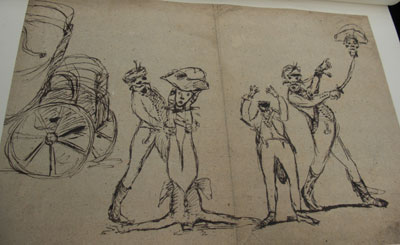The High German Method of Destroying Vermin at Rat-stadt
This pitiless print was prompted by the attack on three French diplomats at Rastatt after peace talks between the French and representatives of the Holy Roman Empire had broken down at the end of April, 1799. The diplomats were caravaning back to Paris in separate coaches. Two of the dipomats, Antoine Bonnier and Claude Roberjot (identified by their names on the boxes behind the carriage in the background), were murdered outright; the other, Jean de Bry (seen on the far right), sustained numerous wounds to his head and body but survived to return to Paris, where he was re-elected as President of the Council of Five Hundred.

© Trustees of the British Museum
The attack was widely reported in British and international newspapers but details differ from source to source. Here is one account published in London Lloyd Evening Post, May 15 edition.
No sooner had they set off ln the evening of the 28th, and proceeded to the distance of a short quarter of a league, than some people, having the appearance of hussars, fell in with the carriages. It was dark; the French Ministers were stopped, and their passports demanded of them. Bonnier is said to have refused to give any farther account than answering, that they were the French Ministers who were on their return to France. A violent altercation took place; and the melancholy acts of outrage were committed. Bonnier had his head split, and one hand cut off; Citizen Roberjot shared the same fate—and both were killed on the spot! Jean de Bry received some cuts on the head and breast, but was not killed. . . . The carriages of the Ambassadors were entirely plundered of all they contained, and Bonnier was stripped to his shirt and pantaloons.
Another account from a different source in the same newspaper is less specific but perhaps more frightening indicating that the diplomats were simply "cut to pieces." and adding that Roberjot's wife " saw her husband cut down, weltering in his blood, and, whilst writhing in the last agonies of death, finally killed by repeated blows."
But no account is quite as cruel and bizarre as Gillray's with its two decapitated ministers spouting blood from their necks—the head of one spiked at the end of a hussar's sword and the other (Bonnier) held between the feet of his inverted body.
Just as disconcerting, however, is the attitude expressed in the title with its purposeful misconstruction of the location of the peace talks (Rat-Stadt for Rasstadt) and its suggestion that the hussars were simply disposing of rats i.e. "Vermin."
The print is signed by Gillray as the etcher, not the designer ("Gillray f."). But in this case we are lucky enough to have the amateur sketch, now in the British Museum, that Gillray used for his print.

[May 1799]
© Trustees of the British Museum
Photo by Jim Sherry
Gillray must have been working under a compressed timeline. The news of the attack did not appear in London newspapers until May 15 and Gillray would not have received the request and sketch until some time after that. As we can see, he follows the basic design provided to him just as he usually did in such cases. But, again as usual, he improves upon the sketch—bringing the action closer to the viewer, correcting the drawing of arms and legs, making all the figures fuller and more vivid, and adding background attackers in pursuit of de Bry. In sum, making a horrible image of a horrible event just that much more horrible.
Sources and Reading
- Commentary from the British Museum on The High German Method of Destroying Vermin at Rat-stadt.
- "Ange-Élisabeth-Louis-Antoine Bonnier," Wikipedia
- "Claude Roberjot," Wikipedia
- "Jean Debry," Wikipedia
- "Second Congress of Rastatt," Wikipedia
- Thomas Wright and R.H. Evans, Historical and Descriptive Account of the Caricatures of James Gillray #242.
- Thomas Wright and Joseph Grego, The Works of James Gillray, the Caricaturist; With the History of His Life and Times, p. 260.
Comments & Corrections
NOTE: Comments and/or corrections are always appreciated. To make that easier, I have included a form below that you can use. I promise never to share any of the info provided without your express permission.